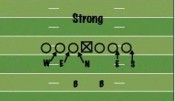Synchronized movements to apply defensive pressure
A question asked frequently within defensive circles is, When is the best time to apply defensive pressure? We believe the answer to this question is from the opening kickoff to the final play. The most difficult football games for me to view are those in which the defense sits and allows the offense to control the tempo. Offenses are highly efficient when they understand pre- and post-snap alignments and assignments.
 We are an odd-front defensive unit, which becomes multiple by utilizing directions with our defensive front. We align in 40 (head-up position on both tackles and the center) with our interior lineman.
We are an odd-front defensive unit, which becomes multiple by utilizing directions with our defensive front. We align in 40 (head-up position on both tackles and the center) with our interior lineman.
Defensive directions
We have four directions that we use: strong, weak, inside and outside. We always tag the OLB away from the direction as our rush end. The OLB to the direction of the play is called the Free Baller. This player is free to find his fit on run support and lock on a receiver if he reads pass. The tags give us the ability to bring three-, four- or five-man pressure.
 DIAGRAM 1: Strong. In this instance, both the nose tackle and the defensive end on the weak side move toward the guard while W moves into the tackles space.
DIAGRAM 1: Strong. In this instance, both the nose tackle and the defensive end on the weak side move toward the guard while W moves into the tackles space.
On the other side of the ball, both that sides end and S hit the outside of the blocker in front of them while trying to get penetration.
 DIAGRAM 2: Weak. In this instance, the roles simply are reversed with the strong-side end and NT going after the guard while the S tries to penetrate on the strong-side tackles side.
DIAGRAM 2: Weak. In this instance, the roles simply are reversed with the strong-side end and NT going after the guard while the S tries to penetrate on the strong-side tackles side.
The W and weak-side end go to the outside of the blocker on front of them.
 DIAGRAM 3: Inside. For Inside, the NT hits the center squarely while both ends rush to the outside of the respective guard on their side of the ball.
DIAGRAM 3: Inside. For Inside, the NT hits the center squarely while both ends rush to the outside of the respective guard on their side of the ball.
The W and S rush to the outside of the respective tackle on their side of the ball. These movements create inside pressure.
 DIAGRAM 4: Outside. For Outside, The W and S attack the outside shoulder of the ends in front of them. The DEs go after the outside shoulder of the tackles in front of them. The NT his the center squarely.
DIAGRAM 4: Outside. For Outside, The W and S attack the outside shoulder of the ends in front of them. The DEs go after the outside shoulder of the tackles in front of them. The NT his the center squarely.
We are always concerned with attacking three offensive run plays: isolation, power and trap. In practice, our players have to see as many reps as possible in a 20-minute inside-run period. We do not take runners to the ground, which allows us to maximize our time.
We group midline and inside veer as inside-isolation plays, and outside veer is grouped with power plays that hit off-tackle. These particular run-fits set the foundation for what we do as a unit.
Alignments & responsibilities
We get depth off the football by aligning the NT at 12 inches and the DEs at 18 inches. We do this to allow our players more effective vision for recognizing blocking schemes. Our DEs attack the point of emphasis when the directions are away by attacking the near hip of the guard. The NT attacks the near hip of the same guard because he is assigned to the opposite A-gap away from the direction.
Our reason for doing this is to not have our ILBs responsible for backside A-gap (cutback). We want our ILBs to fill all open windows and scrape to the flow of the football if the windows are closed.
 DIAGRAM 5: Open. When there are open windows, you want your ILBs to fill. In this instance, the guard moved to hit the NT, so your ILB attacks the opening and fills the window.
DIAGRAM 5: Open. When there are open windows, you want your ILBs to fill. In this instance, the guard moved to hit the NT, so your ILB attacks the opening and fills the window.
 DIAGRAM 6: Closed. When the windows are closed, such as here when the guard hits the NT and the tackle moves into the guards space, your ILB then scrapes to the outside while your DE goes inside.
DIAGRAM 6: Closed. When the windows are closed, such as here when the guard hits the NT and the tackle moves into the guards space, your ILB then scrapes to the outside while your DE goes inside.
Responses to blocking schemes
Our defensive linemen have specific responses to blocking schemes.
Defensive linemen squeeze downblocks, maintain leverage on reach blocks, cross-face with inside pulls and redirect with outside pulls.
 DIAGRAM 7: Down. When the offensive line downblocks, your defensive linemen squeeze.
DIAGRAM 7: Down. When the offensive line downblocks, your defensive linemen squeeze.
 DIAGRAM 8: Reach. When the offensive line reach blocks, your defensive linemen maintain leverage.
DIAGRAM 8: Reach. When the offensive line reach blocks, your defensive linemen maintain leverage.
 DIAGRAM 9: Inside Pull. When the offensive line inside pulls, your defensive linemen cross-face.
DIAGRAM 9: Inside Pull. When the offensive line inside pulls, your defensive linemen cross-face.
 DIAGRAM 10: Outside Pull. When the offensive line outside pulls, your defensive linemen redirect.
DIAGRAM 10: Outside Pull. When the offensive line outside pulls, your defensive linemen redirect.
Give your defensive lineman counter punches. If they are being washed down, instruct them to redirect outside. If they are being turned out, we cross-face to the inside.
As with any system, your role as a coach is to get your players to buy into this system and product.
When a player plays defense at our school, we tell him that he will get the chance to do two things: rush the passer and play pass defense. We have incorporated this philosophy for all 11 positions and it gets players excited about playing defense for us.
Since dedicating our defense to directions, we now do not have to call a perfect game to secure a victory. Directions also allow us to keep the offense guessing and forces the opposition into playing defense on the offensive end.





